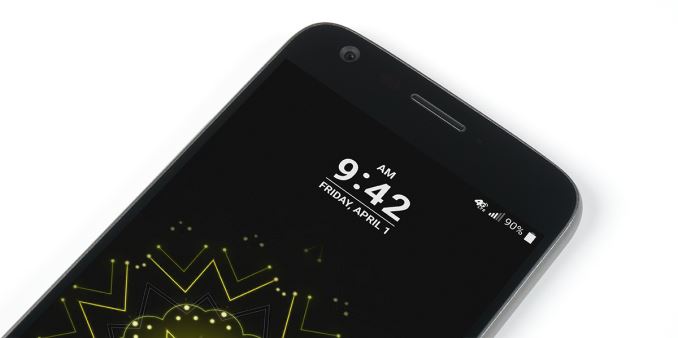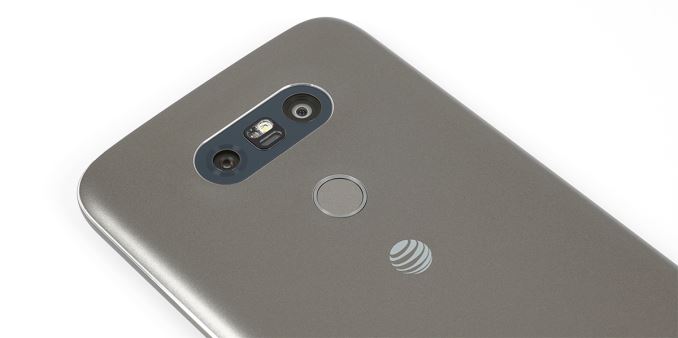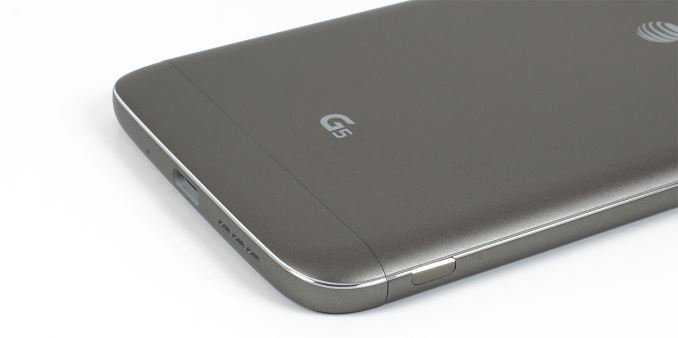The LG G5 Review
by Matt Humrick on May 26, 2016 8:00 AM EST- Posted in
- Smartphones
- Snapdragon
- Qualcomm
- LG
- Mobile
- Snapdragon 820
- LG G5
Final Words
With so many smartphones to choose from, it’s difficult for any one device to stand out. This is especially true for flagships that come packed with the best hardware and nearly every feature available. The implementation of these features and how they contribute to a positive user experience—a bright screen with accurate colors, a fingerprint reader that’s fast and accurate, a high resolution camera that actually takes good pictures, software enhancements that improve usability and customizability without adding bloat—was a differentiator in the past, but I would argue that with the smartphone market maturing and the price modern flagships sell for, there’s little room for compromise here either.
The G5 comes with an impressive list of hardware, but combining a removable battery with an aluminum unibody design is the G5’s big innovation and highlight feature. LG’s mechanism works well, with two minor exceptions: The chin section requires some work before it pulls free and the plastic battery retention scheme raises some concern about durability.
The modularity this design affords is a bonus, but we’re not sure this idea will catch on. Currently there’s only two modules available: the LG CAM Plus, which is a hand grip that adds physical buttons for some camera controls and comes with its own larger battery, and the LG Hi-Fi Plus with B&O PLAY, which adds a Hi-Fi DAC for audio playback (not available in the U.S.). There is an HDK and SDK, which opens the door for third-party modules in the future, but the G5 will need to sell in sufficient quantities to make it worthwhile for companies to develop them. Also, the design of any future LG phones will need to be dimensionally compatible with the G5 or the current modules will no longer work. Maintaining this design constraint for more than a couple generations seems impractical.
The G5’s design and materials are a big departure from previous G Series phones. While the appeal of its new appearance is open for debate, we can definitively say that its ergonomics are excellent. The rounded corners and curved back edges eliminate pain points when holding the phone, and the polished step where the back meets the sides provides enough purchase to keep the phone from feeling slippery. The front is covered by LG’s 3D Arc Glass, which adds a large radius along the top edge where the speaker is located. This too serves an ergonomic purpose: It helps the phone lay more naturally against your ear and eliminates another sharp edge.
With a Snapdragon 820 SoC, 4GB of LPDDR4 RAM, and UFS 2.0 storage, the G5 uses much of the same internal hardware as other flagship phones of its generation. It’s no surprise then that it delivers excellent performance. While the Kirin 950 and 955 SoCs in Huawei’s Mate 8 and P9, respectively, perform better than the G5’s Snapdragon 820 in our system tests, and the G5 is a tick slower than its peers in our web tests, its Adreno 530 GPU is a top performer and the phone feels plenty fast in general.
There are several implementation issues that negatively impact the G5’s user experience, however, starting with the display’s lack of calibration. It’s exceedingly cold white point gives the screen a noticeable blue tint and grayscale and sRGB color accuracy are poor. The G5’s LCD display is capable of reaching an impressive 800 nits brightness using LG’s Daylight Mode feature with auto-brightness enabled, but this is only temporary. Over a period of two minutes, the display gradually dims until it hits a stable value of 405 nits. Peak brightness is even worse in manual mode: After reaching a peak value of 405 nits, the backlight drops to a stable value of only 334 nits after 45 seconds. LG is a leading supplier of LCDs for mobile devices, and its flagship phones should serve as a showcase for its technology. Sadly, this is not the case for the G5.
Besides the removable battery, the G5’s other semi-unique feature is its dual rear camera. While there are certainly uses for the second wide-angle camera, we feel that the image distortion that results from using a fisheye lens will severely limit how often it’s used. Using the two cameras together could potentially boost image quality for every picture taken and would be a better use of resources, rather than letting one of the cameras always sit idle.
The G5’s rear cameras do take excellent photos in bright light, equaling the Galaxy S7’s image quality, but fall short of expectations in lower-light conditions. The G5 still does well handling white balance and exposure; however, its images show a significant amount of noise that noticeably degrades quality. LG also has not significantly updated the G Series’ video recording capabilities in two years, which puts the G5 on par with current mid-range phones today.
Just below the dual rear camera module is another new feature for the G5: a combination fingerprint reader and power button. While it’s located in a convenient spot, its accuracy is very poor. I have not had this much trouble with a fingerprint sensor since the Galaxy S5. Even when the sensor works it takes multiple attempts. Having to punch in my pin code after five failed attempts was a regular occurrence. I had a similar experience with two different G5’s, so this issue is not because of a single faulty unit.
Ultimately, the G5, like the G4, ends up feeling like an upper mid-range phone rather than a true flagship. It does have a nice array of features, including a removable battery—a true rarity these days—and microSD support, along with excellent performance, but many of its features are poorly executed. If the G5’s price falls to $500 USD or less like it did with the G4, it would be easy to recommend, especially if you need the removable battery. At its launch price, however, it seems overpriced relative to the competition.














92 Comments
View All Comments
osxandwindows - Thursday, May 26, 2016 - link
finally!.zeeBomb - Thursday, May 26, 2016 - link
Damn... This review surprised me! Still won't get it, but nice to have itv finally doneAlexey291 - Thursday, May 26, 2016 - link
As usual their reviews are so late that the devices of the current generation have been bought already by those who was planning to buy them.Unless it's an iPhone ofc. That shit gets a review in a week
tuxRoller - Thursday, May 26, 2016 - link
First, that's probably an exaggeration.Second, there are only a couple of iphone launches every year, at most. That's a much easier load to track compared to the swarm of android devices that dribble out over the year (with a plurality released around March, tbh).
marcolorenzo - Sunday, May 29, 2016 - link
So what? Why does it matter how many Android devices there are compared to iPhones? The OS has nothing to do with reviewing a phone, that kind of segregation makes absolutely no logical sense. Of course, during this period when several manufacturers decide to release their phones at the same time, the workload of reviewers would suddenly spike but it still doesn't excuse the delays they have during other times of the year. Let's just face facts. IPhones, like sex, sells. Of course they would double down and getting a review of the latest iPhones out the door, they get more viewers that way.tuxRoller - Sunday, May 29, 2016 - link
It matters because the person I responded to mentioned how iPhone reviews come out relatively quickly. I responded by explaining my understanding of the situation, which is that phones are, in a practical sense, categorized by their OS. Specifically with regards to apple, they are there only ones who produce ios phones, and only make, at most, a couple of releases a year. What's more, those particular phones are the most purchased of any particular phone so interest is highest in them.For Android, the sales distribution is far more diffuse, and Samsung, for one, has at least a couple major releases every year.
When you have a finite amount of man power you have to distribute it in a way that provides the most benefits.
As for their delays during other times, there were, iirc, mitigating circumstances(reviewers were sick, schoolwork, etc). If you have actual knowledge that indicates otherwise I'd be interested.
anoxy - Monday, May 30, 2016 - link
Wait, are you really that dense? You answered your own question but you're still throwing a hissyfit?More phone releases = more workload = increased delays in using (adequately) and reviewing every phone.
There are usually two iPhones, and they likely receive review units well in advance and thus have plenty of time to use them. And yes, there is a greater incentive to review an insanely popular device like the iPhone. Why does that upset you?
Ranger1065 - Friday, May 27, 2016 - link
Nicely written article, but even, "better late than never" barely applies. Anandtech takes another GIANT step, towards obsolescence...Alex J. - Friday, May 27, 2016 - link
I agree, it's pretty disappointing how more and more "late" all of their reviews are becoming... At this rate, the HTC10 review would probably come at the end of the summer.And yea, "better late than never" phrase is also losing its relevancy - most of the people whom I personally know and who were planning to "upgrade" their Android phones this year have already done so, meaning the "late" reviews like this have lost all relevance to them. But whatever - if Purch Media wants to run Anandtech into the ground - it's their choice.
DiamondsWithaZ - Monday, September 19, 2016 - link
It did haha. The HTC 10 review literally just got posted... The phone has been out for almost 6 months.